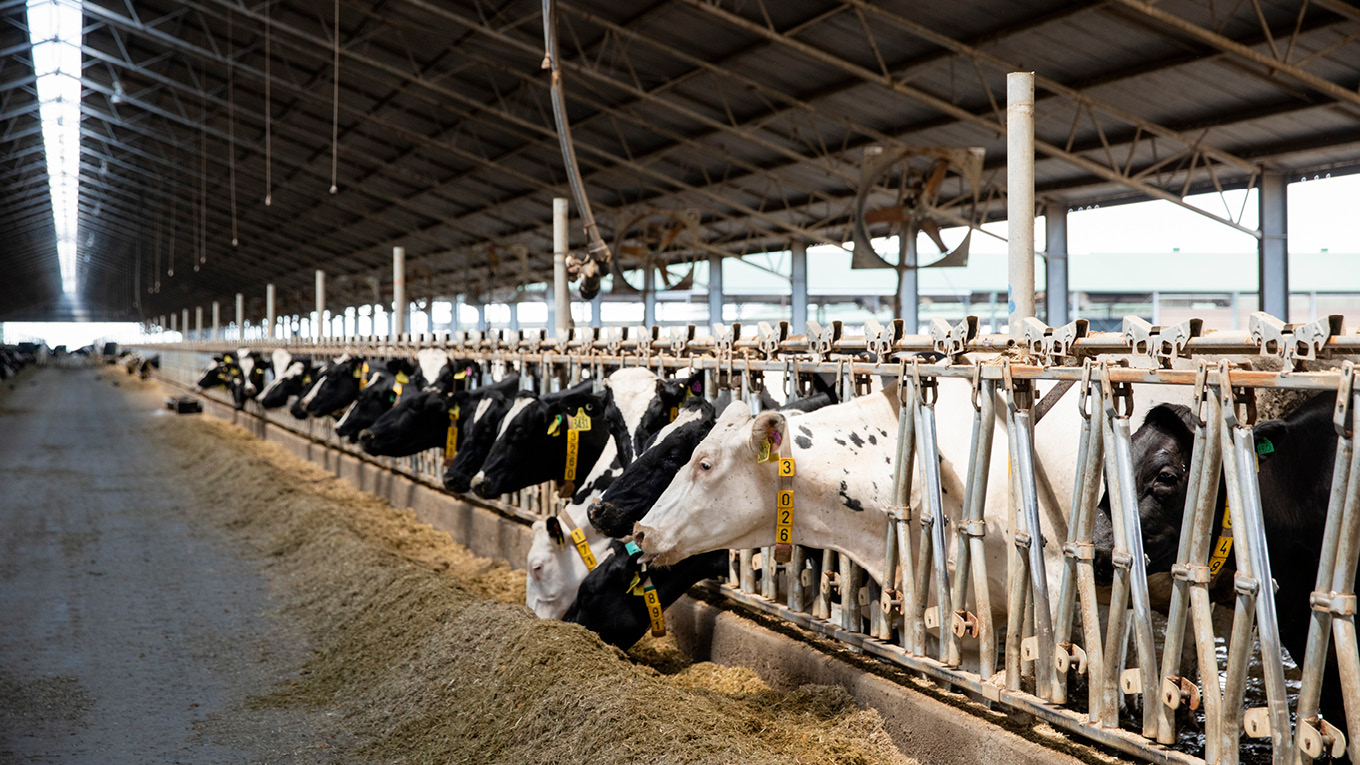Soft-roof Shade Structures
Minimising heat gain using shade should be the first priority for farmers hoping to keep their cows cool.
There are two main options for providing shade in the dairy yard and feed pads.
The cheapest is shade cloth and if well constructed and maintained it can have a lifespan of at least 10 years.
Strengths
- Shade cloth is porous, so heat evaporated from cows can vent through it.
- Can be manufactured off-site then installed in a day.
- Can be removed in cooler months.
- In most council areas no planning permit is required, as shade cloth is not considered a solid roof structure.
Limitations
- Can be affected by hail damage and machinery exhausts.
- Shorter lifespan compared to a solid-roofed structure.
- If not well-designed and constructed, shade cloth can rip in high wind.
Keys to success
- Seek a professional for advice from a registered engineer and/or builder.
- Use shade cloth with a minimum solar rating of 80%, minimum 300 GSM (gram per square metre), and at least a 10-year warranty against UV degradation. Green or black material is preferred.
- Apply tension sufficient enough to shade cloth to prevent damage during windy conditions. Monitor tension regularly, especially after strong winds.
- A minimum height of 3.6m but ideally 4m to allow for adequate airflow under the structure, effective use of sprinklers and fans, and good machinery access.
- A pitched roof is better than a flat roof as it enhances convective air movement.
- Support posts used should be structural grade steel. They should be located outside the dairy yard to prevent contact with manure and water, and so they don’t interfere with yard washing.
- Cure deep footings for an extended period (at least 2-3 weeks) before bearing any load.
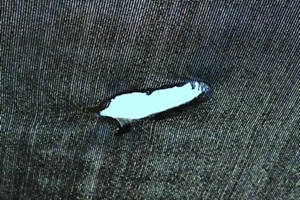
Damage to shade cloth caused by tractor exhaust. This shade cloth structure is only 3.5 m high. Shade structures should be ideally at least 4m.
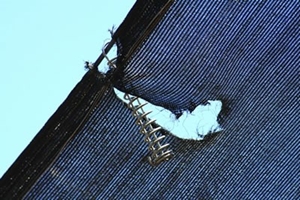
Damage to shade cloth caused by poor maintenance. Ensure that springs that become detached are re-attached as soon as possible.
Shade-cloth structure design
Several forms of shade cloth structures are available including span structures, peaked sail structures, cantilever structures as pictured below and tent like structures with large central supports.
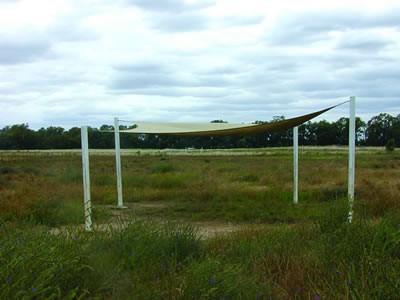
Stresses on shade cloth structures
|
Loading Problem |
Design Solution |
|
Wind Loads |
|
|
Ripples or waves may lead to premature failure |
Ensure the shade cloth is adequately tensioned. |
|
Horizontal winds generating lift (like an aeroplane) |
Flatten to between 10 and 14° or install it with an inclination in excess of 20° . Roof angles of 15 to 18° should be avoided. |
|
Poor materials selection, proneness to ripping in high wind loads. |
Choose adequate fabric strength, lack of structural reinforcement and excessive spans which can lead to billowing. |
|
Dead Loads |
|
|
Gravity |
Brace frames or cables supporting shade cloth are usually used to stay or brace posts. |
|
Poorly distributed loads |
Angled posts provide tension to evenly distribute dead loads but this can also contribute to instability when the cable support is removed. |
|
Cloth impregnated with dust or supporting leaves, twigs, hail, ponded water or wetted from beneath |
Lighter connections and structural system such as cabling |
|
Live loads |
|
|
Hailstones or rainfall cascading down a roof, water pooling on the canopy or being shed through or from shade cloth. |
Regular cleaning and maintenance. Inclusion in maintenance and operational schedules |
|
Human traffic on roof |
Prohibited under WHS/OHS regulations for shade cloth roof structures. |
|
Clogging from water pools |
Regular cleaning and maintenance. Inclusion in maintenance and operational schedules. |
If you intend to install a shade structure, consult a registered builder or structural engineer.
Alternatively, if you are buying a package shade cloth structure ensure that structural computations are supplied, the installers are experienced and local building regulations are met.
-
Design considerations for maximum effectiveness and useful life
Materials selection
Cloth performance requirements to consider:
- blocks at least 80% of sunlight
- minimum 300 grams / sqm (GSM)
- Green or black coloured material
- 10 years age-life, and
- Higher quality and tighter weave fabrics will last longer.
Stressors to consider:
- exposure to sunlight
- dust
- accumulated debris
- water
- flexing, and
- failure or loosening connections.
-
Tension system and maintenance considerations
Load-carrying straps
Regular checks for durability or damage due to loading.
Chains and U-bolts
Chain connections should be avoided. In the event of over-stress, breakage of a link can lead to the launch of a projectile whereas a cable will fray or unravel, allowing time for repair, replacement or escape from injury.
Adjustable cables and turnbuckles
Turnbuckles for tensioning cable supported shade cloth structures are prone to loosening or failure through repetitive loading so they should be inspected regularly and tightened or replaced.
Design notes
- Cows resist being moved from bright areas to dark areas and prefer dappled shaded spaces so they tend to get used to a shade cloth structure more quickly than a solid roofed structure, provided the cloth is not billowing or flapping noisily.
- Shade cloth is also prone to bird, insect and rodent attack and areas not able to be hosed down or easily inspected for maintenance are particularly prone.
-
Support posts and foundations
When installing footings, they should be:
- deep and concreted into the ground
- left to cure for 2 weeks before bearing any load
- free from collisions from animals and vehicles, and
- rigidly attached to a wide steel plate which is mounted on the foundation using bolted connections.
Design notes:
- Galvanised and threaded starter bars extending from the footing reinforcement are better for holding the plate than dynabolts.
- Apart from central supports these posts usually lean against the applied horizontal load to maintain the tension rather than being vertically upright. They need to be free standing in a farm situation. Guy cables must be avoided.
- If possible, position posts outside the animal traffic area so they are not in contact with manure and water or interfere with washing. If are located in the yard, place a raised concrete or PVC sleeve around the pipe to reduce corrosion potential.
-
Fastening fabric to posts
Prevent cloth damage by:
- applying sufficient tension using flexible and adjustable connections to prevent tearing in the wind
- reinforcing cables and seams to distribute the point load at the stanchion to the fabric. This reduces the chance of rips and damage.
If shade cloth fastening is too loose:
- flapping causes excessive flexing and can generate noise during wind events which can disturb cows and irritate people.
If shade cloth fastening is too tight:
- a cable or cable connector could fail due to over-tensioning, i can cause instantaneous and catastrophic structural failure.
Shade cloth structures can become a hazard if damaged by storms. Blown cladding can provide serious injuries whilst broken cables and unsecured shade cloth can whip.
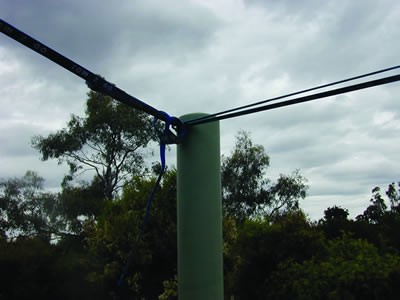
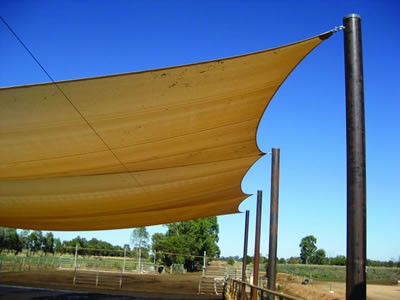
-
Design elements
Height
A minimum height of 4.0 m is recommended.
If it's too low:
- cows might hesitate when entering the area
- it reduces effectiveness and installation of sprinklers and fans.
If it's too high:
- it limits the area of shaded footprint
- maintenance becomes difficult, especially if you're running machinery under the shade cloth, it can become damage from the exhaust.
-
Location considerations
The height of the structure, the angle of winter and summer sun and the required area of shaded footprint govern the orientation of the shade structure north-south or east-west.
If the structure is aligned east west the passage of the sun will generally ensure that the northern side of the structure is more exposed to sunlight than the southern.
If the paving is earthen and subject to animal traffic, drainage should be directed to formed drains.
